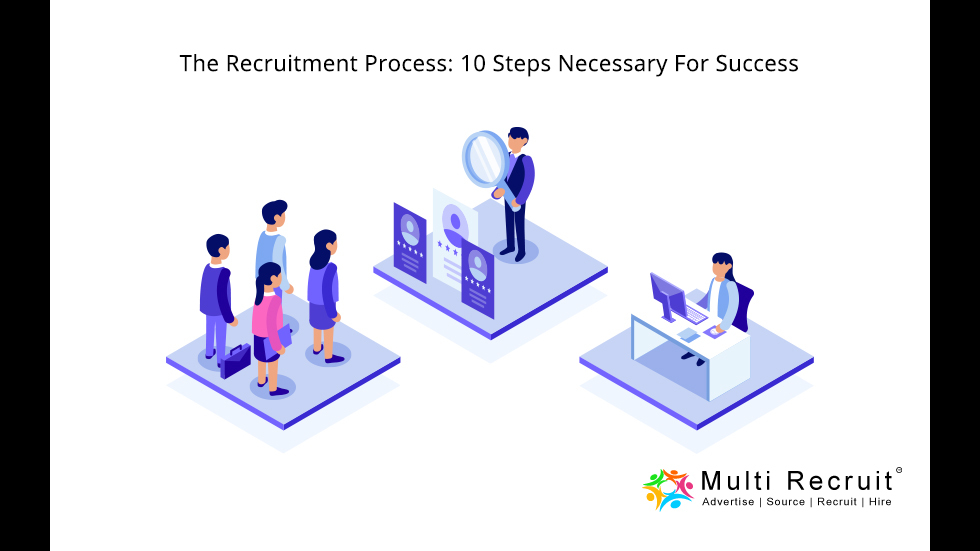The recruitment process encompasses an application to an offer letter – from initial screening (by phone or video) to face-to-face interviews, assessments, background checks, and all the other essential components involved in hiring the right person.
Our ten-step process for recruiting and team building on the other side will help you navigate the recruitment process.
Explore the 10 Steps Necessary For Success
1. Analyze the needs of the company

A company’s needs must be determined before you begin searching for candidates. There might have been a promotion or a departure of someone with critical job duties. Perhaps your company is experiencing some growth that will require shifting responsibilities. However you decide to bring someone on board, the fact remains that a role needs to be filled. It’s up to your HR team and company leadership to define what that means. Searching for the right candidate can only begin once your hiring team has fully defined these needs.
2. Create a job description

It is essential to reflect on what the role entails and who will perform it. How do you translate the needs identified into realistic expectations for your future applicants? You will also have to type up a candidate profile in addition to the role’s specific duties. Prepare a list of the skills and experiences a new hire should possess.
Do Brainstorm your ideal candidate’s qualities. Find out what skills and talents your HR team is looking for.
3. Develop a company pitch

A candidate’s comfort level with your company is just as important as your company’s comfort level with them during the recruitment process. To attract the best applicant pool and make people want to work for your company, you’ll need to do some work to make your company sound appealing. Defining your brand, mission, and value statement is the first step. Review them carefully if you can find them on a website. It is possible that they need some updating, and you wouldn’t want to lose out on an exciting prospective hire due to outdated website pages.
In addition, you should review your internal policies and HR practices to see if any need to be improved. Assess the grievance when the previous employee mentions conflict with paid-time-off policies during the exit interview.
4. Plan your recruitment strategy

Last but not least, a candidate ranking system can save both time and money. As a result, turnover becomes less likely, which, depending on the industry, could be costly. You are also less likely to recruit a superb candidate with a standardized vetting process that eliminates implicit biases.
5. Make Your Job Posting Materials Stand Out

Make sure your writing is clear, concise, and professional, and, if appropriate, include graphics that reflect your organization’s brand and expectations. Ensure that your templates are up-to-date and relevant to the role if you have previously used them.
The final step is to edit these materials carefully. Prospective employees may be turned off by descriptions with excessive typos or unclear language.
6. Search and sort your results

The next step is to manage and sort all the incoming applications once the posts are out there. Consider investing in a tracking system if you think your HR team cannot handle the number of applications. You don’t want to waste time sorting through hundreds of resumes from unqualified candidates.
7. The screening process

8. Candidate interviews

Our next step is to get to know the candidates beyond their resumes.
In some companies, you’ll have a panel interview or a task assessment, while in others, you’ll have a conversation. Your interview process is really up to you, as long as it is consistent with company expectations and any legal requirements.
9. Negotiation of a job offer

I would like to emphasize once more that recruitment is actually about finding the right match between an employer and a potential employee. Labor force matching is heavily influenced by the offer on the table. Choosing a candidate that is competitive will make your company attractive to them.
10. Training and onboarding

Recruiting doesn’t stop once you’ve hired the right candidate. Keeping them will require a concerted effort on your part. In addition to bringing in new employees, HR should ensure the company culture is hospitable and non-discriminatory.
In conclusion
There is a lot to consider when recruiting for a new job, but it doesn’t have to be overwhelming. Keeping your HR team on track when sifting through applicants requires a solid plan and clear company values. Multirecruit helps you screen applicants from a large pool of applicants. Our services include employment background checks, education verification, and pre-employment screening. In order to find the perfect candidate, we know that an extra set of hands can make all the difference. Our background check and screening services are available at Multirecruit. Don’t settle for anything less than a recruit who will help you grow your business.

